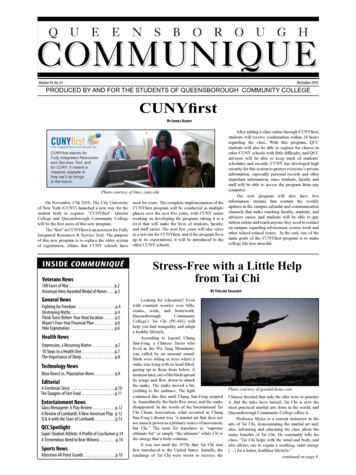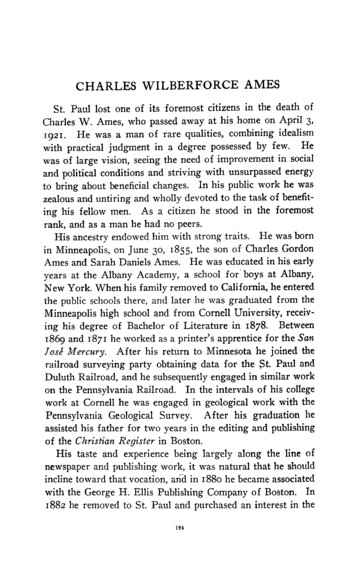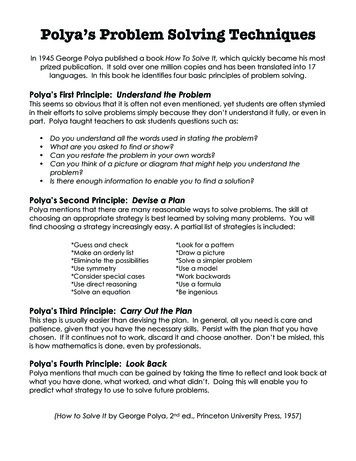
Transcription
Volume XV. No. 63December 2010PRODUCED BY AND FOR THE STUDENTS OF QUEENSBOROUGH COMMUNITY COLLEGECUNYfirstBY JAMES AUDRYPhoto courtesy of bmcc.cuny.eduOn November 17th 2010, The City Universityof New York (CUNY) launched a new way for thestudent body to register: “CUNYfirst”. QueensCollege and Queensborough Community Collegewill be the first users of this new program.The “first” in CUNYfirst is an acronym for FullyIntegrated Resources & Service Tool. The purposeof this new program is to replace the older systemof registration, eSims, that CUNY schools haveINSIDE COMMUNIQUÉVeterans News100 Faces of War . . . . . . . . . . . . . . . . . . . . . . . . p.2American Hero Awarded Medal of Honor . . . . p.3General NewsFighting for Freedom . . . . . . . . . . . . . . . . . . . . .p.4Destroying Myths. . . . . . . . . . . . . . . . . . . . . . . . p.4Think Twice Before Your Next Vacation . . . . . . p.5Mayor’s Four-Year Financial Plan . . . . . . . . . . . p.6Nike Exploitation . . . . . . . . . . . . . . . . . . . . . . . p.6Health NewsDepression, a Recurring Matter . . . . . . . . . . . . p.710 Steps to a Health Diet . . . . . . . . . . . . . . . . . .p.7The Importance of Sleep . . . . . . . . . . . . . . . . . . p.8Technology NewsXbox Kinect vs. Playstation Move . . . . . . . . . . . p.9EditorialA Freshman Story . . . . . . . . . . . . . . . . . . . . . . . .p.10The Dangers of Fast Food . . . . . . . . . . . . . . . . . . p.11Entertainment NewsGlass Menagerie: A Play Review . . . . . . . . . . . . p.12A Review of Lombardi: A New American Play. p.12Q & A with the Stars of Lombardi . . . . . . . . . . . p.13QCC SpotlightSuper Student Athlete: A Profile of Lisa Kurner p.14A Tremendous Need to Bear Witness . . . . . . . . .p.14Sports NewsAttention All Point Guards . . . . . . . . . . . . . . . . . p.16used for years. The complete implementation of theCUNYfirst program will be conducted in multiplephases over the next five years, with CUNY teamsworking on developing the program, taking it to alevel that will make the lives of students, faculty,and staff easier. The next few years will also serveas a test run for CUNYfirst, and if the program livesup to its expectations, it will be introduced to theother CUNY schools.After adding a class online through CUNYfirst,students will receive confirmation within 24 hoursregarding the class. With this program, QCCstudents will also be able to register for classes inother CUNY schools with little difficulty, and QCCadvisors will be able to keep track of students’schedules and records. CUNY has developed highsecurity for this system to protect everyone’s privateinformation, especially personal records and otherimportant information, since students, faculty andstaff will be able to access the program from anycomputer.The new program will also have liveinformation streams that contain the weeklyupdates in the campus calendar and communicationchannels that make reaching faculty, students, andadvisors easier, and students will be able to paytuition online and reach anyone they need to contacton campus regarding advisement, course work andother school-related issues. In the end, one of themain goals of the CUNYfirst program is to makecollege life less stressful.Stress-Free with a Little Helpfrom Tai ChiBY THELMA SALGADOLooking for relaxation? Evenwith constant worries over bills,exams, work, and homework,QueensboroughCommunityCollege’s Tai Chi (PE-441) willhelp you find tranquility and adopta healthy lifestyle.According to legend, ChangSan-Feng, a Chinese Taoist wholived in the Wu Tang Mountains,was called by an unusual sound.Birds were sitting in trees where asnake was lying with its head lifted,gazing up at them from below. Amoment later, one of the birds spreadits wings and flew down to attackthe snake. The snake moved a bit,yielding to the embrace. The fightcontinued like this until Chang San-Feng steppedin. Immediately, the birds flew away, and the snakedisappeared. In the words of the International TaiChi Chuan Association, what occurred in ChangSan-Feng’s dream was “a martial art that does notuse muscle power as a primary source of movement,but Chi.” The term Tai translates as “supremeultimate fist” or simply “the ultimate” while Chi isthe energy that a body contains.It was not until the 1970s that Tai Chi wasfirst introduced to the United States. Initially, theteachings of Tai Chi were sworn to secrecy; thePhoto courtesy of goodalchemy.comChinese decided that only the elite were to practiceit. But the tides have turned; Tai Chi is now themost practiced martial arts form in the world, andQueensborough Community College offers it.Professor Myles is a current instructor in thearts of Tai Chi, demonstrating the martial art and,also, informing and educating his class about themany benefits of Tai Chi. He constantly tells hisclass, “Tai Chi helps with the mind and body, andalso allows one to regain a soothing, calm energy[ ] for a better, healthier lifestyle.”continued on page 9
2Queensborough Communiqué, December 2010VETERANS NEWS100 Faces of WarBy Francisco RomeroPhoto courtesy of100facesofwarexperience.orgRick Yarosh, from Windsor, N.Y., ArmySergeant, Cavalry Scout, BradleyGunner-- Bhagdad, Iraq 12/05-09/06In 2005, Matt Mitchell,an artist from AmherstMassachusetts,startedworking on an ongoingproject called 100 Faces ofWar Experience, a tributethat involves 100 portraitswith individual storiesof those involved in theGlobal War on Terror.Mitchell, a civilianwho has never actuallybeen to war, understandsthe struggles of soldiersand veterans better thanmost. In the beginning,hefeltdisconnectedfrom the wars in Iraqand Afghanistan and wasdisheartened by the factQUEENSBOROUGHC O M M U N I QU ÉAdministration Building, Room 31356th Ave. and Springfield Blvd.Bayside, N.Y. 11364(718) 631-6302Copy Editor & Proof ReaderCaitlin DooleyCommuniqué StaffOluwadamisi K. AtandaJames AudryDianne BhagwansinghBen BrockmanAnnmarie BrownStephanie BuendiaMarlon ChavezJeremy FischerNatalie HaliliAndrea IzquierdoLuis A. JordanAndres LondonoLawrence LubinMaximilian Herbertson McFarlaneMarbel MelendezNicholas OngFrancisco RomeroDavid RussellThelma SalgadoKerris SegeeKeith SwiaderLeon WilliamsTypesetting and DesignJeannie BuxoFaculty AdvisorTammi Rothmanthat he was living ignorantly unaware of the happenings overseas.His move to action began five years ago when he read an articleabout Jeff Lucey, a troubled marine suffering from posttraumaticstress disorder, who took his own life ten months after returningfrom Iraq.In an interview conducted by the Boston Globe, Mitchellsaid, “I felt something was wrong; I was ill at ease. There wasno connection between me and war. What disturbed me mostwas the way I continued my life as if nothing whatsoever washappening. I wanted to do something about it.’’ After talking withthe family members of Lucey, he realized how little he knewabout the hardships many veterans experience and decided to telltheir stories through impacting emotional portraits that connectthe viewer with the brave men and women who have fought inIraq and Afghanistan. His first portrait was of Lucey.Mitchell began painting local soldiers from his studio inAmherst and then started to travel around the country to completehis 100 faces. So far, he has completed 38 portraits and hopes toinclude at least one veteran from every state. Along with havingtheir portraits painted, those involved in the project are alsoasked to share their thoughts on anything they want, includingthe wars.One brave soldier, Army Sergeant Rick Yarosh, wrote in hispersonal statement, “Whether it’s a look in the mirror, or thethought of a lost friend, it all goes back to that day. Sergeant LuisMontes, Specialist Andrew Loe and I loaded into our Bradley,ready for a full day of patrols. After a short time, our vehicle washit by an IED [Improvised Explosive Device]. The fuel cell ignitedand engulfed us in flames. We escaped the Bradley exceptionallyfast. I escaped out the top hatch of the turret. I knew I needed toget off the vehicle. With my face on fire, I didn’t know where theedge of the Bradley was and when I did find the edge, I didn’tknow where the ground was. When I jumped off the Bradley,I broke my right leg, severing an artery, which resulted in anamputation.”He continued, “‘Stop drop and roll’ is no way to put out a firewhen you’re covered in fuel. I found that out while I was rollingon the ground, doing nothing but setting the grass on fire. I endedup rolling in a canal, which extinguished the flames. The lostfriend I speak of is Sergeant Luis Montes. He passed away dueto his injuries seven days later. Specialist Andrew Loe survivedwith 20% burns, but the thought of that incident goes throughhis mind every day. I’m lucky and blessed to be here. I’m ableto share my story with others. That day started the same as everyother day, but that day has never ended.”In an article titled, “One Hundred Faces Of War Gives SoldiersA Voice” by Margot Adler, Yarosh states, “My features are totallydifferent from anybody else [ ] no ears, no nose, my eyes aredifferent, my lips are different, the scars, how do you capturethat? But Matt did it, and I really didn’t know if I expected to seethe finished product the way it was, and it was perfect.” He alsosays that despite his disfigurement, he is proud of his service, thatit was a choice, and he feels good about it.This project is more than just a work of art; it exists to remindus of the many sacrifices our brave men and women in uniformedservices make overseas. Through their portraits and stories, weare able to understand the nature of these wars and honor thoseindividuals who protect our freedom.
Queensborough Communiqué, December 20103VETERAN NEWSAmerican Hero Awarded Medal of HonorBY LUIS A. JORDANPhoto courtesy of Associated PressThree years after acts of battlefield bravery in the Korengal Valley ofAfghanistan, Army Staff Sergeant Salvatore Giunta of Haiwatha, Iowabecame the first living service member in nearly 40 years to receive thenation’s top military award, the Medal of Honor.During a ceremony at the White House in Washington on Nov.16th, President Barack Obama awarded Giunta the Medal of Honor forconspicuous gallantry and intrepidity at the risk of his life above andbeyond the call of duty. Obama called Giunta a soldier who is “as humbleas he is heroic” and said the ceremony was a “joyous occasion.”On Oct. 25, 2007, Giunta and his comrades were heading singlefile down steep terrain when an insurgent ambush split the group intotwo. Arial support overhead saw what was happening but couldn’tengage the enemy so close to U.S. soldiers. Another platoon heard thegunfire but was too far away to help. The two lead men were struck byenemy fire. After a third went down from a bullet to his helmet, Giuntabraved enemy fire to pull him to safety. Giunta was hit twice by roundsthat struck his body armor and shattered the weapon slung across hisback. His unit regrouped, lobbing grenades and using the explosions tocharge ahead until they reached one of the two lead men. Giunta thenbolted forward, again ducking enemy fire, until he reached a hill, sawthe insurgents taking away his friend and opened fire.The standards for earning the nation’s highest military honor areso high that many recipients are only so honored posthumously. BothObama and his predecessor, George W. Bush, had come under pressurebecause no living member from the Iraq or Afghanistan wars had beenawarded a Medal of Honor.Though Giunta’s actions predate Obama’s time in office, they tookplace during a war that’s more closely identified as belonging to Obama,who has added tens of thousands of troops to the effort in Afghanistan.As commander in chief, Obama ultimately approved therecommendation that Giunta receive the medal. Recommendations forthe Medal of Honor work their way up through the military chain ofcommand until eventually they are approved at the highest levels of thePentagon and finally by the president.
4Queensborough Communiqué, December 2010GENERAL NEWSFighting for FreedomBy BEN BROCKMANBozella’s visit to the QCC campusImagine being left alone in a room with no way of communicating to theoutside world. Imagine that you can only see your loved ones twice a month.Imagine being restricted to four walls, and your only source of movement is towalk in the perimeter of your room. Imagine being told to wake up at a certaintime and to go to sleep at a certain time. Imagine being on alert whenever yougo to sleep because there’s a chance that someone might try to assault you whileyou’re sleeping. Imagine having to take a shower with at least fifty other peopleof the same sex. Imagine being forced to shave your hair. Imagine that themusic you enjoy is restricted and prohibited, and you can’t watch your favoriteTV show because you’re not allowed to own a TV. Imagine that everythingyou ever owned is taken away from you, and you are isolated and restricted toa facility where you are constantly watched. Imagine having to live like this for26 years.After spending 26 years behind bars, an innocent man was finally set free.Dewey Bozella at the age of 24 was charged with murder for killing a 92 yearold woman despite the lack of physical evidence linking Bozella to the killingand the discovery of a fingerprint of another man, Donald Wiser, who waslater convicted of committing a similar murder of another elderly woman. Theprosecution relied entirely on the testimony of two men with criminal histories.Both men repeatedly changed their stories and received favorable treatment intheir own cases in exchange for their testimonies.Mr. Bozella was given multiple plea-bargain offers during his trial. He wasoffered a chance to accept a lesser charge in return to walk free. Mr. Bozellasaid, “I could never admit to something I didn’t do.” He sacrificed his life bynot acquiescing to the pressure of giving a false confession. While in prison,he obtained his bachelor’s degree
Stephanie Buendia Marlon Chavez Jeremy Fischer Natalie Halili Andrea Izquierdo Luis A. Jordan Andres Londono Lawrence Lubin Maximilian Herbertson McFarlane Marbel Melendez Nicholas Ong Francisco Romero David Russell Thelma Salgado Kerris Segee Keith Swiader Leon Williams Typesetting and Design Jeannie Buxo Faculty Advisor Tammi Rothman











